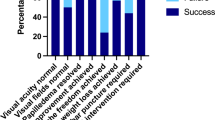Abstract
The cause of idiopathic intracranial hypertension (IIH) remains unknown, and no consensus exists on how patients should be monitored and treated. Acetazolamide is a common treatment but has never been examined in a randomised controlled trial. The objectives of this pilot trial are to prospectively evaluate the use of acetazolamide, to explore various outcome measures and to inform the design of a definitive trial in IIH. Fifty patients were recruited from six centres over 23 months and randomised to receive acetazolamide (n = 25) or no acetazolamide (n = 25). Symptoms, body weight, visual function and health-related quality-of-life measures were recorded over a 12-month period. Recruited patients had typical features of mild IIH and most showed improvement, with 44% judged to have IIH in remission at the end of the trial. Difficulties with recruitment were highlighted as well as poor compliance with acetazolamide therapy (12 patients). A composite measure of IIH status was tested, and the strongest concordance with final disease status was seen with perimetry (Somers’ D = 0.66) and optic disc appearance (D = 0.59). Based on the study data, a sample size of 320 would be required to demonstrate a 20% treatment effect in a substantive trial. Clinical trials in IIH require pragmatic design to involve sufficiently large numbers of patients. Future studies should incorporate weighted composite scores to reflect the relative importance of common outcome measures in IIH.

Similar content being viewed by others
References
Friedman DI, Jacobson DM (2002) Diagnostic criteria for idiopathic intracranial hypertension. Neurology 59:1492–1495
Durcan F, Corbett J, Wall M (1988) The incidence of pseudotumor cerebri: population studies in Iowa and Louisiana. Arch Neurol 45:875–877
Wall M, George D (1991) Idiopathic intracranial hypertension. A prospective study of 50 patients. Brain 114:155–180
Corbett J, Savino P, Thompson H et al (1982) Visual loss in pseudotumor cerebri. Arch Neurol 39:461–474
Lueck C, McIlwaine G (2005) Interventions for idiopathic intracranial hypertension. Cochrane Database Syst Rev 20(3): CD003434
Rowe F, Sarkies N (1998) Assessment of visual function in idiopathic intracranial hypertension: a prospective study. Eye 12:111–118
Radhakrishnan K, Thacker AK, Bohlaga NH, Maloo JC, Gerryo SE (1993) Epidemiology of idiopathic intracranial hypertension: a prospective and case-control study. J Neurol Sci 116:18–28
Newborg B (1974) Pseudotumor cerebri treated by rice reduction diet. Arch Intern Med 133:802–807
Johnson LN, Krohel GB, Madsen RW, March GA Jr (1998) The role of weight loss and acetazolamide in the treatment of idiopathic intracranial hypertension (pseudotumor cerebri). Ophthalmology 105:2313–2317
Amaral J, Tsiaris W, Morgan T, Thompson W (1987) Reversal of benign intracranial hypertension by surgically induced weight loss. Arch Surg 122:946–949
Rubin RC, Henderson ES, Ommaya AK, Walker MD, Rall DP (1966) The production of cerebrospinal fluid in man and its modification by acetazolamide. J Neurosurg 25:430–436
Celebisoy N, Gokcay F, Sirin H, Akyurekli O (2007) Treatment of idiopathic intracranial hypertension: topiramate vs acetazolamide, an open-label study. Acta Neurol Scand 116:322–327
Ball AK, Clarke CE (2006) Idiopathic intracranial hypertension. Lancet Neurol 5:433–442
Clarke CE (2004) A cure for Parkinson’s disease: can neuroprotection be proven with current trial designs? Mov Disord 19:491–498
Bruce BB, Kedar S, Van Stavern GP et al (2009) Idiopathic intracranial hypertension in men. Neurology 72:304–309
Craig JJ, Mulholland DA, Gibson JM (2001) Idiopathic intracranial hypertension; incidence, presenting features and outcome in Northern Ireland (1991–1995). Ulster Med J 70:31–35
Sugerman HJ, Felton WL, Salvant JB Jr et al (1999) Gastric surgery for pseudotumor cerebri associated with severe obesity. Ann Surg 229:634–642
Sinclair AJ, Burdon MA, Nightingale PG et al (2010) Low energy diet and intracranial pressure in women with idiopathic intracranial hypertension: prospective cohort study. BMJ 340:c2701
Kleinschmidt JJ, Digre KB, Hanover R (2000) Idiopathic intracranial hypertension: relationship to depression, anxiety and quality of life. Neurology 54:319–324
Daniels AB, Liu GT, Volpe NJ et al (2007) Profiles of obesity, weight gain and quality of life in idiopathic intracranial hypertension (pseudotumor cerebri). Am J Opthalmol 143:635–641
Orcutt JC, Page NG, Sanders MD (1984) Factors affecting visual loss in benign intracranial hypertension. Ophthalmology 91:1303–1312
Author information
Authors and Affiliations
Corresponding author
Rights and permissions
About this article
Cite this article
Ball, A.K., Howman, A., Wheatley, K. et al. A randomised controlled trial of treatment for idiopathic intracranial hypertension. J Neurol 258, 874–881 (2011). https://doi.org/10.1007/s00415-010-5861-4
Received:
Revised:
Accepted:
Published:
Issue Date:
DOI: https://doi.org/10.1007/s00415-010-5861-4




